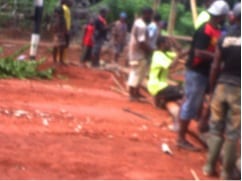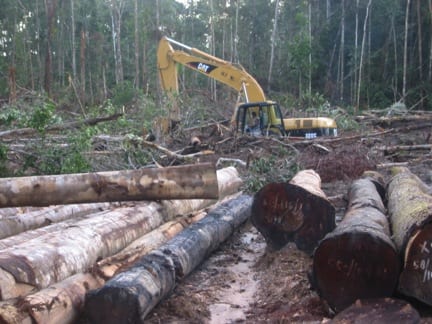
This palm oil company promised destruction – and it delivered.
The palm oil industry has become notorious for deforestation and abuse of indigenous communities. Some companies have made progress in addressing these issues through the adoption and implementation of strong forest conservation and human rights policies. However, deforestation is continuing across Indonesia because of rogue companies that are attempting to evade these new environmental and social requirements on a vast scale.
We’ve always thought these companies knew exactly what they were doing, knew the damage their wholesale destruction of forests would do to ecosystems and communities. But it’s rare to see explicit proof of companies’ foreknowledge of the massive impacts they cause. However, exactly that type of proof recently fell into Mighty Earth’s lap.
We recently received the social and environmental impact assessment that was submitted to the Indonesian government in 2009 as part of the permitting process for establishing a 39,000 hectare palm oil plantation called PT Bio Inti Agrindo (PT BIA). The plantation is located in Papua, Indonesia’s largest remaining intact rainforest. The plantation is now owned by the South Korean conglomerate POSCO Daewoo. All palm oil companies in Indonesia are required to submit these assessments, known as “AMDALs”, but rarely are these AMDALs seen by the public.
Throughout the assessment, the company explicitly acknowledges the devastating impacts its development would have on the environment and on the local community. What’s truly sad is that all of the impacts the company anticipated came true. Unfortunately, the Indonesian government licensed PT BIA for development despite the consequences detailed in the assessment, underscoring the leniency of the Indonesian Government’s permitting process for palm oil and other industrial development at the time.
There are dozens of pages of anticipated negative impacts listed in the report. Among the most shocking:
- Polluting the Bian and Fly Rivers with toxic waste, despite acknowledging that the community uses these rivers daily for drinking, bathing, and fishing. While it does state an intent to build a wastewater treatment facility, the report acknowledges that the pollution levels are likely to exceed the facility’s capacity.
- Destroying the habitat of several protected species, including the tree kangaroo, through the conversion of native forest to monoculture plantation.
- Increasing the risk for severe public health impacts like the spread of malaria, ISPA (acute respiratory tract infection), and diarrhea due to the water pollution and ecosystem changes.
- Constructing the palm oil plantation on customary lands.
- Spurring social restlessness, conflict and anarchy.
See below for selected excerpts:
“B. THE SOUNDING OF SIGNIFICANT AND IMPORTANT IMPACT
Result of impact identification and prediction as spelled out in the document of Reference Framework on Environmental Impact Analysis (KA-ANDAL) is that the subject matters of impact due to this activity plan of oil palm plantation project construction and the construction plan of PT Bio Inti Agrindo’s processing plant, in Papua province are as follows:
- (1) the degradation of Bian River’s and Fly River’s water quality
- (2) the increasing rate of soil erosion
- (3) the disturbance to protected Flora /vegetation and Fauna/wild animals
- (4) local community’s complaint and restlessness (community’s perception)
- (5) community’s health”
PT BIA outlined the expected intensity and duration of the impact of its development as follows (bold font added for emphasis):
“• The use of local people’s communal right on land: temporary, during the commencement period of construction
- The upgrade of dust’s degree: every day, during the activity period (25 years)
- The degradation of water quality due to PKS waste: every day, during the activity period (25 years)
- The increase of boar and rat pest: 5-6 years during the commencement period of construction
- The damage of road due to excess load of CPO: every day, during the activity period (25 years)
The nature of community’s perception impact (complaints and restlessness) above if the source of impact is not managed well, it is estimated to occur a conflict and social anarchy.”
In reference to the impact on community health specifically, PT BIA expected:
“The nature of impact of oil palm plantation and processing plant construction activity plan on community’s health parameter is deemed as a negative impact. The oil palm plantation activity and the dumping of liquid waste into Bian and Fly rivers will have an impact on the health of those communities using the rivers for daily purpose. This will trigger the emergence of various diseases such as malaria, ISPA (acute respiratory tract infection), and diarrhea.
The emergence of malaria disease is based on such considerations like among others the disturbance of mosquito habitat existing at the project site and the entry of occupants who are in general susceptible to malaria disease.
The intensity of impact will occur continuously until the end of activity.
The other environmental component going to suffer the impact of this community’s health is social restlessness (community’s perception). By the degradation of community’s health condition and the emergence of various diseases, it will result in social restlessness (community’s perception that tends to be negative).”
Indeed, several of these exact impacts were described to Mighty Earth in July 2017 during a meeting with Pastor Nikodemus Rumbayan MSC, Parish Pastor in Muting, one of the villages affected by PT BIA. He especially emphasized the pollution of the Bian River due to the dumping of palm oil waste, the worsening health condition of the community, and the rising social tensions due to the land conflict between indigenous clans that was spurred by PT BIA’s development. These impacts were also revealed in a recent article published in the South Korean weekly news magazine SisaIN, which was based on interviews with affected community members.


The environment and social impact report also admitted that the project would harm the habitat of fauna in the area of PT BIA, including several protected endangered species. Here are just a few excerpts:
“The nature of this wild animals relocation and migration impact constitutes a secondary impact due a change to the animals’ habitat function due to a change to secondary forest’s vegetation to become an open area and monoculture crops. The subsequent impact is the migration of those animals to another area or the decrease of protected animals population in said area covering:
- Protected animal species : cuscus (Phalanger gymnotis), tree kangaroo (Dendrologus ursinus), and deer (Cervus timorensis).
- Protected aves species: cassowary (casuarius casuarius), fish eagle (Pandion haliaetus), big beak parakeet (tanygnathus megalorinchos), blue chest Cendrawasih (Ptiloris magnificus), and yellow crest cockatoo (cacatua galerite)
- Protected reptile species: fresh water crocodile (Crocodilus novaeguineae), Irian turtle (Carettachelys coraceae) and lizard (Varanus gouldi).”
It describes the potential impact on these protected species as follows:
“Onshore fauna /wild animals; the construction activity of oil palm plantation as a whole is potential to degrade the quality of wild animals’ habitat existing at the study area. In addition to habitat, this activity is also potential to decrease the abundance of animals’ feed in the form of vegetation (herbivora) and animals (carnivora). In the review on wild animals preservation, it is not only the protected wild animals need to maintain, but also the other animals being the feed of carnivora that need to maintain. The activities estimated to damage wild animals’ habitat is land preparation (land opening) and road network building activities
Aquatic biota; as the subsequent impact of the degraded water quality is the degradation of aquatic biota’s habitat (plankton, nekton and benthos)”

“The impact of oil palm plantation and processing plant construction activity on this wild animals is deemed as an important negative impact with significant weight of impact (-3) based on the following considerations:
(1) the loss of original vegetation will reduce the population of protected wild animals of quite wide diversity, due to the loss of their habitat functioning as a place to find feed, nesting, egging, and breeding, even though certain animals will undergo a migration out of the study area
- (2) the presence of outsiders working at the project area, tends to cause a potential decrease of unique wild animals, due to a demand for being owned and raised (for aves species) even for being taken their meat (deer) through hunting
- (3) the migration of wild animals particularly boar and rat will potentially become a pest for plants, either oil palm plant or community’s feed plant, that might impact on the death/damage of cultivation crops which shall be detrimental to the community
- (4) the impact characteristic of this wild animals’ migration can be classified as permanent impact, except for mobile species (certain aves)”
“The impact of oil palm plantation construction plan on nature’s vegetation constitutes a primary impact where by total felling down system, the floristic composition in the existing land will be replaced with monoculture vegetation system. Further, since the previous existing vegetation constituted a habitat of various wild animals (protected and non-protected ones), then this impact is classified as an important impact.”

While it’s impossible to reverse all of the damage its already caused, POSCO Daewoo must immediately enact a moratorium on forest clearing in order to do no further harm, adopt a comprehensive group-level No Deforestation, No Peat, and No Exploitation policy, and undertake credible sustainability assessments (High Carbon Stock and High Conservation Value) aligned with the industry benchmark for responsible production, the High Carbon Stock Approach. In addition, POSCO Daewoo must take responsibility for the negative impacts PT BIA knowingly brought to the environment and communities in Papua. It should invest in extensive forest restoration, clean up the Bian and Fly rivers until water quality is restored to its original condition, and seek to resolve the social conflicts it has spurred to the satisfaction of the community.
This case also raises questions about whether exciting licenses should be reviewed and, in instances where companies have inflicted significant harm to community health and wellbeing, peatlands, or Indonesia’s dwindling rainforests, revoked.
PHOTOS OF THE PT BIA SITE FROM 2010-2016
2010: FOREST COVER AT THE SITE OF PT BIA


2012: MONOCULTURE PALM PLANTATION HAS ALREADY BEGUN REPLACING THE NATURAL FOREST, FIRES ARE CLEARLY VISIBLE

2012: BULLDOZER CLEARING MORE FOREST

2012: WHAT’S LEFT BEHIND AFTER THE FOREST DESTRUCTION

2016: BOUNDARY BETWEEN THE PT BIA PALM OIL PLANTATION OWNED BY POSCO DAEWOO AND THE STANDING FOREST

Photo credit: Mighty Earth
2016: AERIAL DRONE VIDEO OF PT BIA
Credit: Mighty Earth, June 2016
To read the full social impact assessment, click here.
Caption for banner image: According to Pastor Nikodemus Rumbayan MSC, Parish Pastor in Muting, the village Chief’s wife had to go to the hospital after bathing in the water because her skin broke out in rashes. She was urged to keep quiet about the incident.
Photo Credit: SKP KAMe Merauke


